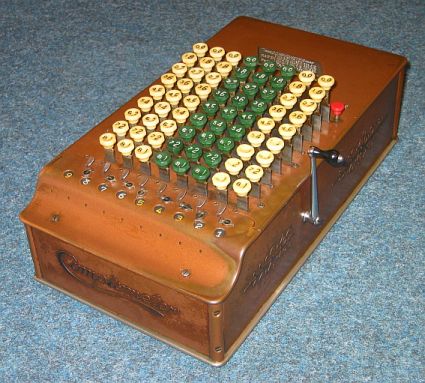previous <<==>> next
COMPTOMETER - J

Have a look at an e l e c t r i c version
T E C H N I C A L D A T A of the Mechanical Calculator COMPTOMETER
************************************************************************
Model >> J <<
Serial Number: J299116
Dimensions: (ca.) Width = 8 " / 20 cm
Depth = 15 " / 38 cm
Height = 6 " / 15 cm
Weight: (ca.) 18 lbs / 8.2 kg
Mechanics: 8*9 Full-Keyboard,
COMPTOMETER-Coding = Instant Additions
Functions: Addition,
Subtraction (& Multiply & Divide) with "Tricks"
Registers: Input = 8 Decimals
Arithmetic = 9 Decimals
Manufacturer:
Felt & Tarrant Mfg.Co.
Chicago, Ill. / USA
1929
HISTORICAL REMARKS
******************
The COMPTOMETER was one of the first mass-produced ADDING machines. The
1st patent was issued in July 1887. It was considered easy-to-use - but
the subtraction procedure seems strange for us now. The "Owner's Manual"
claims it can "Multiplication & Division" too, but the procedures are
complicated. Nevertheless, it was a useful tool for the times. Because
the figures of a number can be entered simultaniously, the COMPTOMETER
was QUICKER THAN a "modern" 10-KEY-ADDING MACHINE of the 70s !
Citation of a book "Calculator Course" (USA, 1942)
--------------------------------------------------
The key-driven calculator, such as the COMPTOMETER, is recognized as one
of the essential office machines upon which modern business depends ...
... and ... is used to perform fundamental arithmetic computations with
speed, accuracy, and efficiency ...
BASICS & HOW TO USE the COMPTOMETER
**************************************
(A) Clearing Register & Entering Data:
--------------------------------------
Pull the CRANK and release it. There are three "Sensations" that occur
when a new calculation is starting:
o SEE: The display shows the row of ZEROS 000...00 HALF COVERED.
o FEEL: The 1st KEY pressed feels HARDER.
o HEAR: A bell is CHIMING.
(B) Error Corrections:
----------------------
If a key is not fully depressed, the COMPTOMETER will lock. To unlock
the machine, press the RED CORRECTION KEY and re-enter the figure.
(C) Decimal Markers:
--------------------
There are 8 small turnable arrows located above the display to indicate
decimal points.
ADDITION:
=========
Addition is performed automatically as soon as a number is entered.
Use the LARGE FIGURES on each key when entering a number!
Example: 123 + 45 + 6 + 789 = 963
--------
Enter the first number 123 into keyboard. Then enter the second number
45 and notice that the intermediate sum 168 is displayed. Next enter 6
and 789 and read the result 963 on display.
Remark:
-------
The "Owner's Manual" suggest to use only the lower-half of the keyboard
to speed-up additions (in saving hand/arm motions) according this table:
instead key 6 press 3 + 3 in sequence
7 3 + 4
8 4 + 4
9 4 + 5
Obviously the method was used, because the lower-half of the keys show
more wear on most COMPTOMETERs.
SUBTRACTION:
============
Addition is the only operation directly performed on the COMPTOMETER.
For subtraction an indirect method of addition is adopted. The keyboard
contains LARGE and a SMALL FIGURES on each key. The small figures are
the machine complements of the large figures:
(Main-)LARGE figures = 1 2 3 4 5 6 7 8 9
SMALL figures = 8 7 6 5 4 3 2 1 0
Note: There is NO LARGE 0 and NO SMALL 9 on the keyboard!
-----
Example (1): 876 - 543 = 333
------------
Use the LARGE FIGURES on the keyboard to enter the pos. number 876. Push
the small (silver) subtraction cut-out lever, located to the left of the
column containing the first figure of the subtrahend (5) and hold it.
Use the SMALL FIGURES on each key to enter the negative number MINUS 1
(enter 543 - 1 = 542 ) into keyboard. Release the cut-out lever and
read the result 333 on display.
NOTE to the following EXAMPLES:
-------------------------------
Enter the positive number (in LARGE FIGURES) first ...
Example (2): 765 - 493 = 272
------------
When 9 APPEARS INSIDE THE SUBTRAHEND, no key is pressed in the column in
which it appears, because there is NO SMALL 9 KEY!
Push and hold the cut-out lever left of the 3rd column. Press the SMALL
4 KEY for 400, NO KEY for 90 and the SMALL 2 KEY (for 493 - 1 = 492 ).
Release the cut-out lever and read the result 272 on display.
Example (3): 987 - 965 = 22
------------
When 9 APPEARS AS THE FIRST FIGURE IN THE SUBTRAHEND, the column should
be treated as if it were used even though no key is to press!
Push and hold the cut-out lever left of the 3rd column. Press NO KEY for
900, the SMALL 6 KEY for 60 and the SMALL 4 KEY (for 965 - 1 = 964 ).
Release the cut-out lever and read the result 22 on display.
Example (4): 456 - 78 = 378
------------
When THE SUBTRAHEND HAS FEWER DIGITS, place a zero at the beginning in
the column in which something would be borrowed - as if the problem were
being done by the paper-and-pencil method.
Push and hold the cut-out lever in the column to the left of the zero.
Press the SMALL 0 KEY for the zero, and the SMALL figure KEYS for the
amount of the subtrahend MINUS 1. Release the cut-out lever.
Example (5): 654 - 302 = 352
------------
When A ZERO APPEARS INSIDE THE SUBTRAHEND, the procedure is the same as
in example (1), but be aware, that THERE ARE SMALL 0 KEYS!
Example (6): 7654 - 3200 = 4454
------------
When SUBTRAHEND ENDS WITH ZERO(S), "MINUS 1" refers to the last non-zero
digit: Enter the subtrahend as 31__ in SMALL figure KEYS.
Because: 3200 - 1 = 3199 and there are no small 9 keys, ignor the zeros!
Multiplication & Division:
============================ Have a look at the MODEL H ...
Have a look at "Calculating Trickies" ...
impressum:
************************************************************************
© C.HAMANN http://public.BHT-Berlin.de/hamann 10/19/06
|